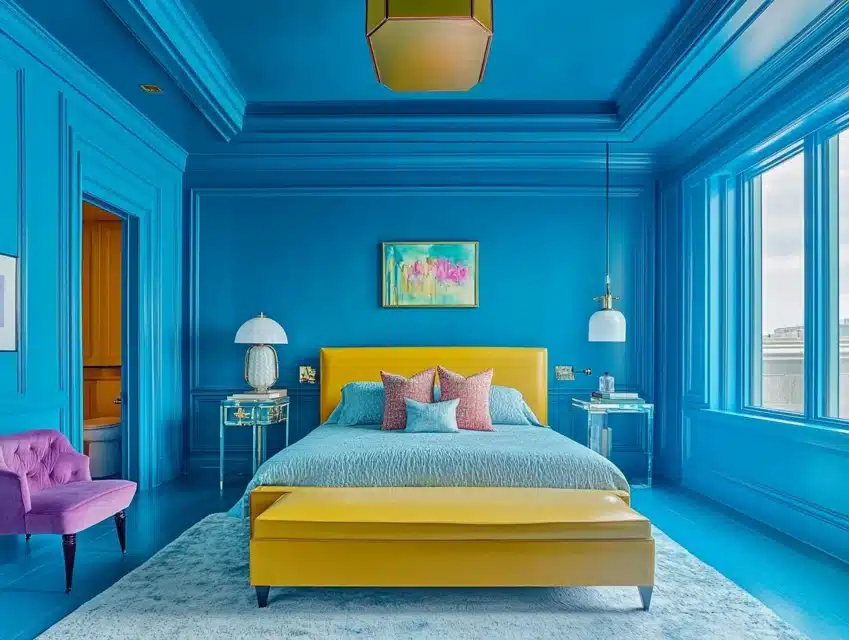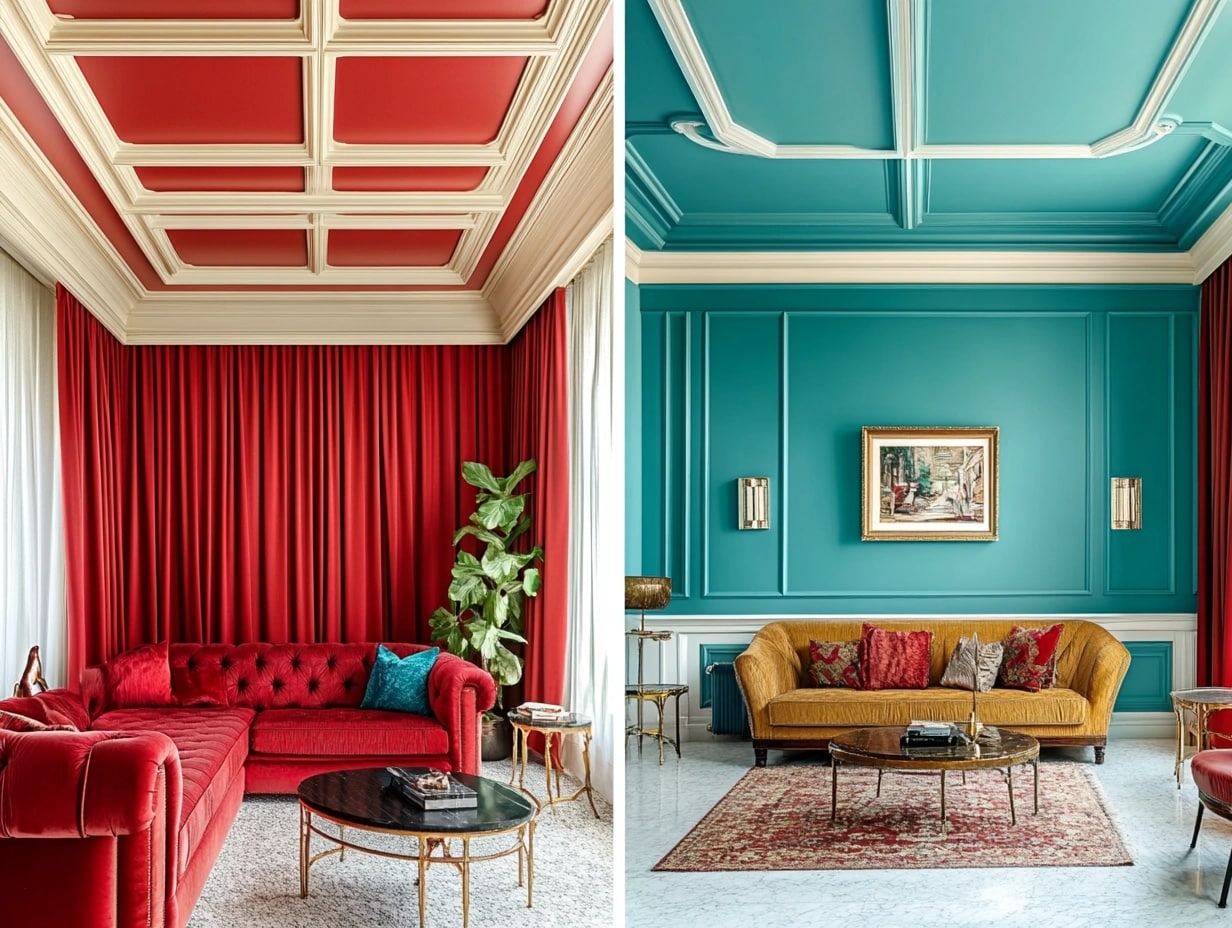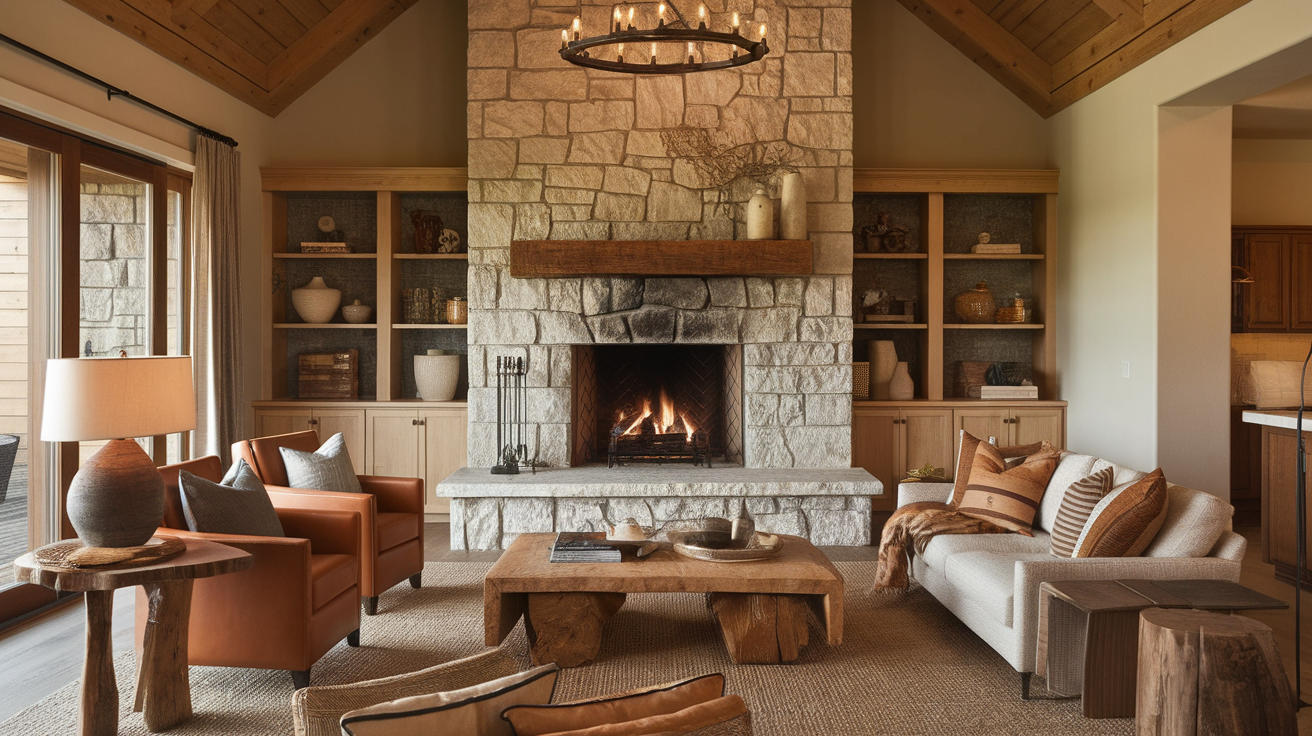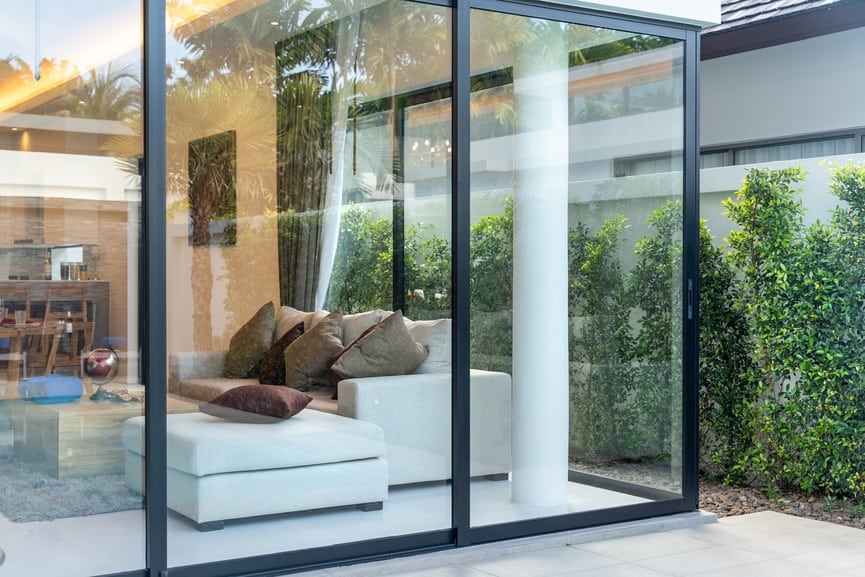Should You Paint Your Ceiling the Same Color as Your Walls?
Have you ever walked into a room and felt an immediate sense of harmony and flow?
Chances are, you were experiencing the effect of a design choice quietly transforming interiors: painting the ceiling the same color as the walls.
This approach offers something to offer whether you are aiming for a cozy, intimate atmosphere or an open and airy feel.
But does this technique suit every space? How does it affect the overall vibe of a room, and what are the potential pitfalls?
In this guide, I’ll explain this design trend, its benefits, challenges, and tips for making it work in your home.
What Is Painting Ceilings the Same Color as Walls?

Painting ceilings the same color as walls is a design approach that involves extending the wall color up onto the ceiling.
This technique breaks away from the traditional notion of ceilings being painted white or left untouched.
Instead, it turns the ceiling into an integral part of the room’s design rather than an afterthought.
This approach has its roots in both minimalist and modernist design philosophies, where simplicity and cohesion are key.
Over time, it has become popular across a range of styles, from contemporary to eclectic, proving that it’s far more versatile than one might initially think.
Why It Works
- Eliminates Visual Breaks: By keeping the color consistent, it removes sharp lines between walls and ceilings, creating a unified and expansive feel.
- Modern Aesthetic: The technique aligns with the clean and cohesive look that many modern homes strive for.
- Versatility: It works in both bold, statement-making spaces and soft, serene interiors.
What Is Color Drenching?

Color drenching takes the concept a step further by saturating the entire room in a single hue.
This includes the walls and ceiling, trim, doors, and even furniture.
It’s an immersive design choice that creates a bold, enveloping atmosphere.
If you’ve ever wanted your space to feel like a curated art installation, color drenching might be for you.
1. Key Features of Color Drenching
- Intensity: The room becomes a statement piece, with the chosen color dominating the palette.
- Depth: Using the same color on multiple surfaces emphasizes texture and detail.
- Mood Setting: Whether it’s a calming sage green or an energetic coral, the color determines the room’s emotional impact.
2. Examples of Color Drenching
Imagine a room entirely in a rich navy blue. Walls, ceiling, and trim are all painted the same color, while furniture and accents provide subtle variations in tone.
The result? A dramatic, cocoon-like space that’s both intimate and luxurious.
On the other hand, a room drenched in soft blush pink creates a serene, dreamy retreat—perfect for bedrooms or reading nooks.
Benefits of Painting Ceilings and Walls the Same Color
1. Creates the Illusion of Space
One of the most compelling reasons to paint your ceiling the same color as your walls is its ability to transform how a room feels.
By eliminating the stark contrast between wall and ceiling, you create a sense of continuity that can make a room appear larger and more open.
How It Works
- Eliminates Visual Barriers: Sharp transitions between different colors can visually “chop up” a room. Using a single color removes these boundaries, making the space feel unified and expansive.
- Works Wonders in Small Spaces: If you have a small bedroom or a cozy nook, this trick can give the illusion of higher ceilings and more room to breathe.
Real-Life Example
When I first painted my tiny home office with the same soft gray on the walls and ceiling, the change was incredible.
The space, which previously felt closed-in and cramped, suddenly felt open and inviting, even though the square footage hadn’t changed.
It was a game-changer for both the look and the functionality of the room.
2. Enhances Cohesion and Flow
If you’ve ever walked through a home where every room feels disconnected, you know how jarring that can be.
Painting the ceiling the same color as the walls brings a sense of flow, tying all the elements together.
Why It’s Effective
- Seamless Design: The absence of contrasting colors directs the focus to other design elements, like furniture, art, and textures.
- Perfect for Open-Concept Spaces: In homes with open floor plans, this technique helps unify different zones, such as the living room, dining area, and kitchen.
Design Tip
To enhance this effect, stick to a single color palette throughout your home.
For example, if your walls and ceilings are painted a light greige, carry that tone into adjoining spaces through furniture or accessories.
3. Sets the Mood and Atmosphere
Color is more than just decoration—it’s a powerful tool for setting the tone of a room.
Matching your ceiling to your walls amplifies this effect, creating a more immersive atmosphere.
Color and Mood
- Dark Colors for Intimacy: Navy, deep green, or charcoal can create a cozy, cocoon-like vibe, perfect for bedrooms or libraries.
- Light Colors for Airiness: Whites, creams, or pale pastels evoke openness and tranquility, ideal for bathrooms and living rooms.
Personal Experience
In my dining room, I chose a warm terracotta shade for both the walls and ceiling.
The result was a rich, enveloping ambiance that made the space feel intimate and inviting for dinner parties.
It was like dining in a stylish café every evening!
4. Highlights Architectural Features
When walls and ceilings are the same color, architectural elements stand out more prominently.
Beams, moldings, and decorative trims become the stars of the show rather than blending into the background.
Design Applications
- For Beamed Ceilings: Painting the beams a contrasting color while keeping the walls and ceiling the same shade adds depth and dimension.
- Crown Moldings: Matching crown molding to the walls and ceiling creates a sleek, contemporary look.
Pro Tip
If you’re working with intricate details like coffered ceilings, consider a slightly darker or lighter shade of the same color for contrast without breaking cohesion.
Factors to Consider Before Deciding
Before painting your ceiling the same color as your walls, it’s important to evaluate various aspects of your space and your personal preferences.
Here are the key factors that can guide your decision.
1. Room Size and Ceiling Height
The size of your room and the height of your ceiling play a critical role in determining whether this technique will enhance or hinder your space.
Small Rooms
- Illusion of Space: Matching the ceiling and walls can create a seamless flow, making the room feel larger.
- Soft, Light Colors Work Best: Use lighter shades like whites, creams, or pastels to prevent the space from feeling boxed in.
Large Rooms
- Cozier Atmosphere: In expansive rooms, a uniform color scheme can add warmth and intimacy.
- Bolder Colors Work Too: In bigger spaces, you can experiment with darker tones like deep grays or muted greens without overwhelming the area.
Low Ceilings
- Elevating the Look: Matching colors can make low ceilings appear higher by reducing visual breaks.
- Choose Wisely: Stick with neutral or soft tones to avoid making the space feel cramped.
High Ceilings
- Adding Drama or Coziness: Uniform paint can bring high ceilings visually closer, creating a cozy feel.
- Consider Color Depth: Darker shades can make vast ceilings feel more intimate, while lighter hues keep the space airy.
2. Lighting Conditions
Lighting is one of the most important considerations when deciding on a unified ceiling and wall color scheme.
Natural and artificial light can dramatically alter how a color appears.
Natural Light
- North-Facing Rooms: Tend to have cooler, indirect light, which can make colors appear darker and more muted. Warm tones work well here.
- South-Facing Rooms: Receive ample sunlight, making colors appear brighter. Neutral or slightly cooler shades can balance the warmth.
- East and West-Facing Rooms: Colors will shift throughout the day as the light changes, so test paint in these spaces at different times.
Artificial Lighting
- Bulb Type Matters: LED lights tend to enhance cool tones, while incandescent bulbs bring out warm tones.
- Layered Lighting: Use a mix of overhead, task, and ambient lighting to highlight the paint’s true qualities.
Tips
- Test Swatches: Always paint samples on both walls and ceilings to see how they interact with light.
- Observe at All Hours: Colors can look drastically different in the morning, afternoon, and evening.
3. Color Psychology
The color you choose for your ceiling and walls will influence the room’s mood and how it feels to spend time in the space.
Cool Tones
- Blues, Greens, and Grays: Create a calming and serene atmosphere, ideal for bedrooms, bathrooms, and studies.
- Best for Relaxation: These tones work particularly well in spaces meant for rest or quiet focus.
Warm Tones
- Reds, Oranges, and Yellows: Evoke energy and warmth, making them great for dining rooms, kitchens, or playrooms.
- Add Vibrancy: Use these colors to make larger spaces feel lively and inviting.
Neutrals
- Whites, Beiges, and Grays: Offer flexibility and timeless appeal. Perfect for nearly any room and decor style.
- Easy Pairing: Neutrals work well with colorful furniture or accents.
4. Surface Preparation
Uniform paint schemes require a flawless surface to achieve a professional and polished look.
Why It Matters
- Imperfections Are Amplified: Matching paint can make cracks, bumps, or uneven textures stand out more.
- Preparation Is Key: A smooth surface ensures that the color looks consistent across walls and ceilings.
How to Prepare
- Clean Thoroughly: Remove dust, grease, and cobwebs from both walls and ceilings.
- Fill and Sand: Repair any cracks or holes and sand rough areas for a uniform texture.
- Prime First: A high-quality primer helps the paint adhere evenly and enhances the final look.
Step-by-Step Guide to Painting Ceilings and Walls the Same Color
Now that you’ve considered the key factors, it’s time to dive into the practical process of painting your ceiling and walls the same color.
Follow this step-by-step guide to achieve a flawless and cohesive look in your space.
1. Planning Your Project
Careful planning ensures that the end result meets your expectations and minimizes surprises.
- Choose the Right Paint Type:
- Matte Finish: Hides imperfections and creates a soft, sophisticated look.
- Satin or Eggshell Finish: Offers durability and easy cleaning, ideal for high-traffic areas.
- Calculate Materials: Measure your walls and ceiling to determine the amount of paint you’ll need. Don’t forget to factor in extra for touch-ups.
- Pick Quality Tools: Invest in high-quality brushes, rollers, and painter’s tape for a professional finish.
2. Preparation
Preparation is crucial for ensuring that your paint job looks polished and lasts for years.
- Clear the Room: Remove furniture, or cover it with drop cloths. Protect floors with tarps or plastic sheets.
- Gather Supplies:
- Paint (ceiling and wall-friendly)
- Rollers with extension poles
- Angled brushes for edges
- Painter’s tape for trim
- Ladder or step stool
- Test the Color: Apply swatches on your walls and ceiling to observe how the color looks under different lighting conditions.
3. Surface Preparation
A smooth surface is essential for achieving even color application.
- Clean the Walls and Ceiling: Wipe surfaces with a damp cloth to remove dust, dirt, and grease.
- Fill Imperfections: Use spackle or filler to repair cracks, holes, or dents. Sand down rough areas for a uniform finish.
- Apply Primer:
- Use a primer that matches your paint type for better adhesion and even coverage.
- A tinted primer can help enhance the final color, especially if you’re using darker shades.
4. Painting Techniques
The painting process requires attention to detail to avoid streaks and ensure uniformity.
- Start with the Ceiling:
- Use a roller with an extension pole for smooth and even application.
- Begin in the center of the ceiling and work your way outwards in overlapping strokes.
- Cut in the Edges: Use an angled brush to paint along the edges where the ceiling meets the walls.
- Move to the Walls:
- Start at the top and work down to avoid drips.
- Maintain a “wet edge” by working in small sections to prevent lap marks.
5. Finishing Touches
The final steps ensure that your paint job looks polished and complete.
- Inspect Your Work: Look for missed spots or uneven coverage and touch them up as needed.
- Remove Painter’s Tape: Peel off tape carefully before the paint dries to avoid peeling.
- Clean Your Tools: Wash brushes and rollers thoroughly for future use. Dispose of materials responsibly.
Expert Tips and Advice
As with any design choice, there are nuanced strategies to make painting your ceiling the same color as your walls a successful and impactful decision.
These expert tips will help you navigate the process with ease and achieve a professional look.
1. Selecting the Right Finish
Choosing the right paint finish is key to achieving the desired aesthetic and functionality.
Matte Finish
This finish creates a soft, velvety look and is excellent for masking surface imperfections. It works beautifully in living rooms or bedrooms where you want a calm, understated feel.
Satin or Eggshell Finish
Perfect for high-traffic areas like kitchens and hallways, this finish provides a slight sheen, making the surface easier to clean without appearing overly glossy.
High-Gloss Finish for Trim
If you choose matching trim, consider a high-gloss finish for a subtle contrast. This creates depth and enhances the overall design.
2. Color Recommendations
Not all colors are created equal when it comes to this technique. Here are some tried-and-true suggestions:
Neutrals
Shades like soft grays, warm beiges, and creamy whites create a timeless look and pair well with a variety of furniture styles.
Bold Colors
Deep hues like navy blue, forest green, or terracotta can make a striking statement. Pair them with ample lighting and minimalist decor to avoid overwhelming the space.
Pastels
Light shades of lavender, pale yellow, or mint green bring a refreshing and serene vibe, making them ideal for bedrooms or nurseries.
3. Balancing the Space
When you extend the wall color to the ceiling, it’s important to balance the overall look with thoughtful decor choices.
Introduce Textures
Incorporate rugs, curtains, or cushions with varying textures to create visual interest.
Contrast with Furniture
Use furniture in contrasting tones to break up the monochromatic scheme, like dark wood or light upholstery.
Add Artwork and Accents
Wall art and decor elements can pop against a uniform background, allowing them to stand out beautifully.
4. Avoiding Common Mistakes
Steer clear of these pitfalls to ensure your project is a success:
Skipping Surface Prep
Painting over a bumpy or flawed ceiling can make imperfections more noticeable. Take the time to smooth surfaces properly.
Overlooking Lighting Conditions
Always test the color in your space. A shade that looks perfect in a showroom may look entirely different in your home.
Using the Wrong Tools
Invest in high-quality rollers and brushes to achieve an even finish. Cheap tools often result in streaks and uneven coverage.
5. Think About Trim and Accents
Deciding whether to match or contrast the trim is a personal choice, but here are some suggestions:
-
Matching Trim:
For a seamless, modern look, paint the trim the same color as the walls and ceiling. This eliminates visual interruptions and highlights the overall color scheme. -
Contrasting Trim:
Use crisp white or a complementary shade for the trim to add definition and structure. This is especially effective in rooms with architectural details like crown molding.
6. Incorporating Texture and Material
Enhance the visual interest of a monochromatic scheme by pairing it with textural elements:
Wood Accents
Warm, natural wood furniture or beams can add a cozy, earthy feel.
Stone or Metal
Incorporate stone finishes, metallic light fixtures, or mirrors to reflect light and break up the uniformity.
Fabric Layers
Use layered textiles like chunky throws, velvet cushions, or linen curtains to add softness.
Conclusion
Painting your ceiling the same color as your walls is a transformative design choice that brings a sense of cohesion and creativity to any space.
This technique allows you to craft a room that reflects your personality, whether you’re aiming for a bold, moody ambiance or a seamless, airy feel.
While it offers numerous benefits like visual flow and architectural emphasis, understanding the potential challenges is key to achieving the desired effect.
By carefully selecting the right color, preparing your surfaces, and balancing lighting, you can turn any room into a masterpiece.
Whether you’re experimenting with neutrals or diving into bold hues, remember: your space should feel like home, and this design approach is all about making that happen.
Frequently Asked Questions
Will Painting the Ceiling the Same Color as The Walls Make My Room Feel Smaller?
Not necessarily. While darker shades can create a cozier, more intimate feel, lighter hues can make the space feel expansive and open.
The key is to consider the room’s size, natural light, and how the chosen color interacts with your furnishings.
Can I Use This Technique in a Bathroom or Kitchen?
Absolutely! This technique works well in bathrooms and kitchens, but it’s crucial to choose the right type of paint. Opt for moisture-resistant or mold-resistant finishes to ensure durability in high-humidity areas.
What Colors Work Best for Matching Ceilings and Walls?
Neutral tones like soft whites, grays, and beiges are classic choices for a seamless look.
However, don’t shy away from experimenting with bold colors like navy, emerald green, or even a dusty rose for a striking, cohesive design.
Should I Match the Trim Color to The Walls and Ceiling?
Matching trim creates a unified, seamless look that can make the room feel larger. If you prefer contrast, a crisp white trim can frame the walls and ceiling beautifully, adding a touch of definition and elegance.
How Can I Test Whether This Technique Will Work in My Space?
Start with paint swatches on your walls and ceiling. Observe how the color changes under different lighting conditions throughout the day. This will help you see if the effect aligns with your vision before committing fully.







